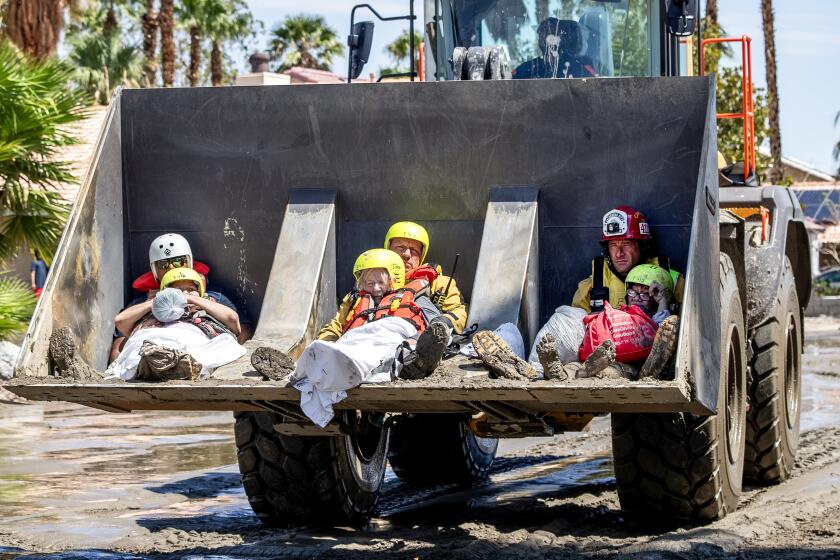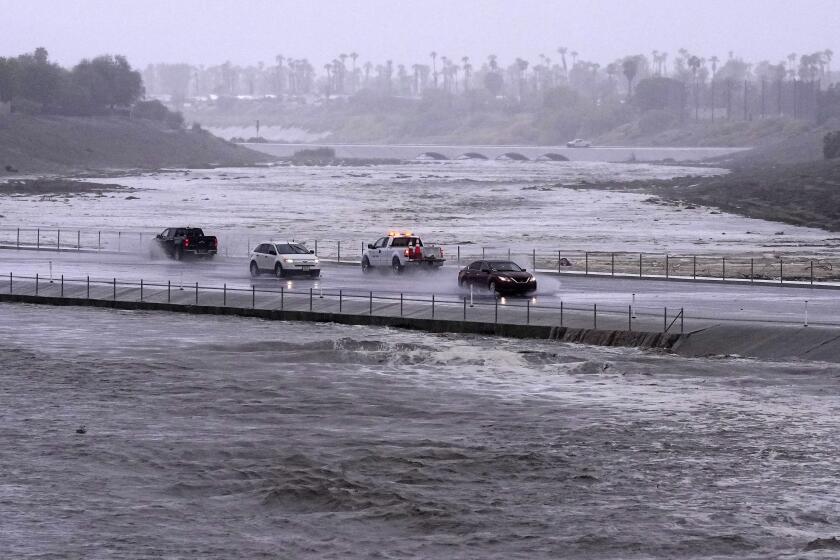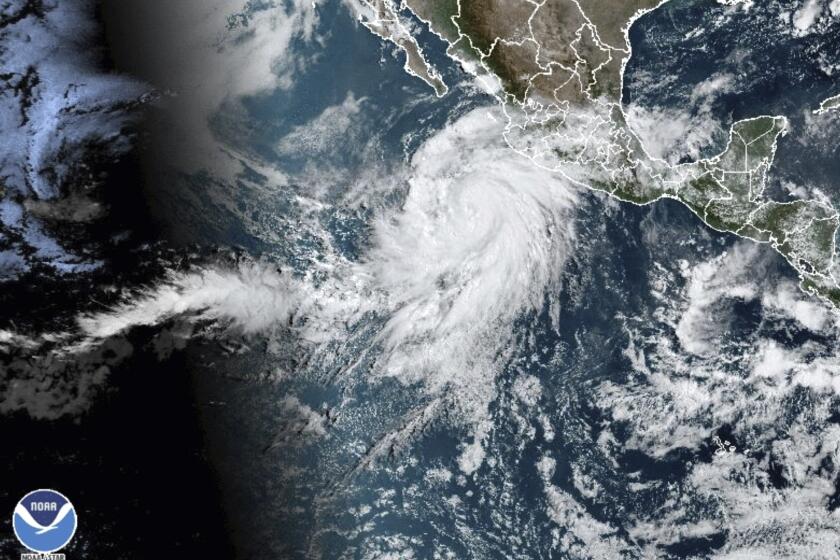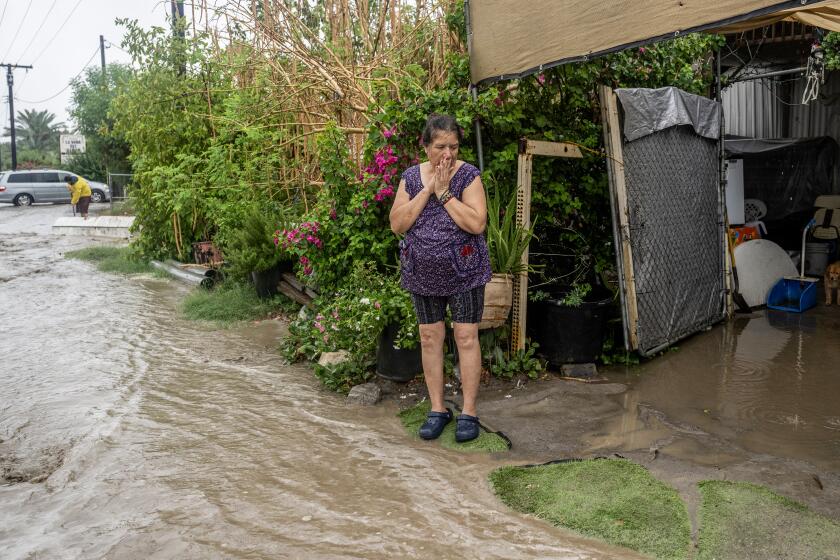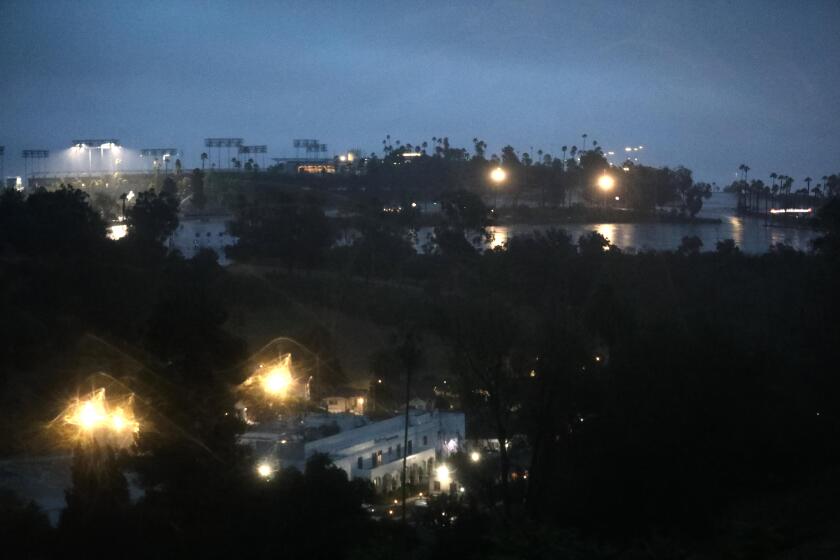Hilary leaves massive flooding, mudslides, upheaval across Southern California
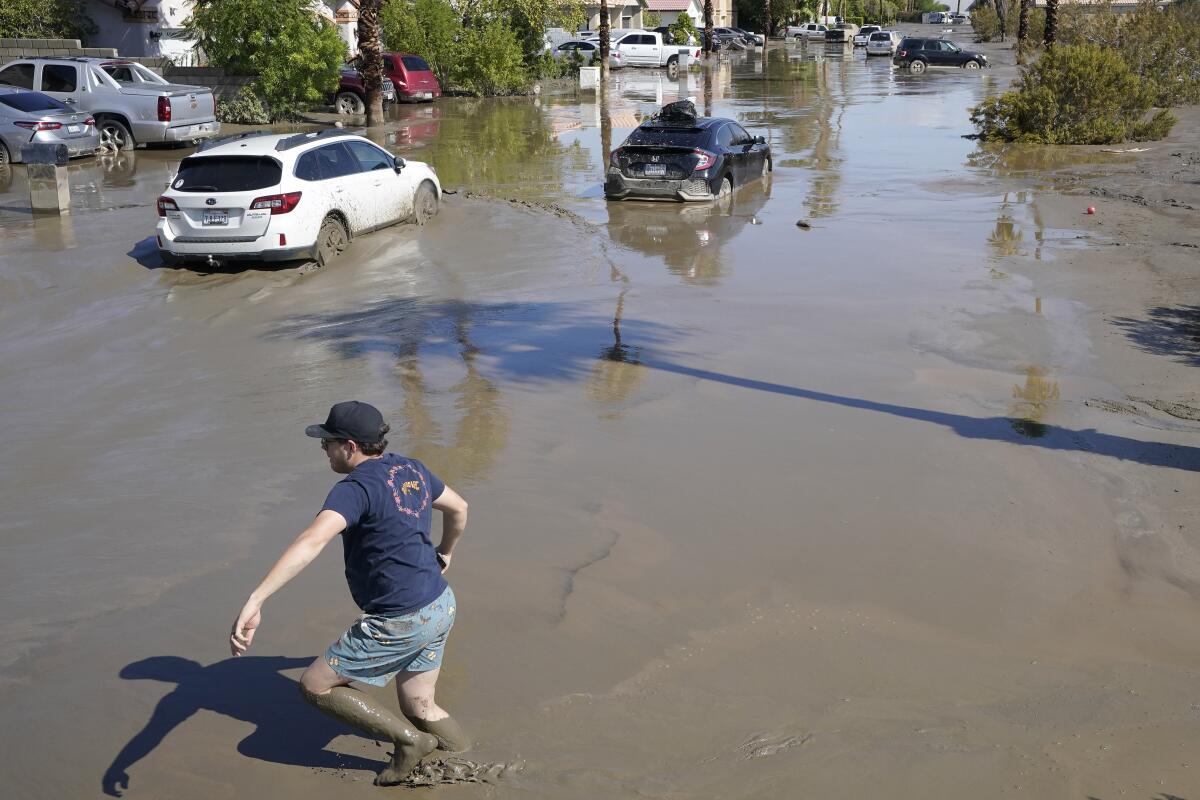
- Share via
Record rainfall. Inaccessible highways. Widespread power outages. Residents stranded. Streets buried or washed out.
In the wake of Hilary’s lashing of Southern California, the region awoke Monday to lingering damage from the historic storm, with debris flows and flash floods leaving paths of destruction from San Bernardino’s mountain towns to Riverside’s desert communities and along Hollywood streets.
In some areas, the storm’s damage is still being assessed as officials work to access cut-off communities and rescue those who were stranded.
“Some places did see rather severe flooding, and that extends actually into Nevada,” Daniel Swain, a UCLA climate scientist, said Monday. But “some areas in Southern California did escape a worst-case flood event.”
Although forecasters, in many cases, predicted the correct rain totals, Swain said, the extremely fast rainfall rates didn’t materialize — sparing the region from much of the “catastrophic” flooding that flashed in warnings.
The Coachella Valley got 2 to 4 inches of rain at lower elevations, including in Palm Springs and Indio, and about 4 to 6 inches farther west, the National Weather Service said.
“Even though the same amount of water fell overall, in many cases, it didn’t fall as quickly as had been feared,” Swain said. Still, severe and dangerous flooding and debris flows spanned the region, especially in the interior mountains and deserts.
At San Bernardino County Fire Station 99 in Forest Falls, a small, unincorporated community near the El Dorado burn scar, the rain transformed a wooded, rocky area into a roaring mudslide, forcing firefighters to run for safety and leaving about 700 residents sheltering in place.
According to video from OnScene, brown water quickly swelled into a wave of rocks, downed tree trunks and other debris that rushed down a hillside near the fire station. Firefighters reported that access to the station was blocked in both directions.
Although debris flows aren’t unheard of during monsoon season, San Bernardino County Fire spokesperson Eric Sherwin said Monday the damage from Hilary was significant. At least eight feet of mud covered Valley of the Falls Drive, shutting off access to much of the Forest Falls community.
“It will take some time to uncover that debris and check the road surface,” Sherwin said. However, he said no injuries or major structural damage had been reported.
Firefighters in the San Bernardino County mountains also were working to access stranded residents in Seven Oaks, where officials expected flooding to have destroyed several homes and prompt high-water rescues, Sherwin said. In Oak Glen, farther south in San Bernardino National Forest, numerous debris flows and downed power lines damaged at least two bridges, Sherwin said.
Tropical Storm Hilary blew past daily rainfall records across Southern California, “just smashing” records across L.A. and Ventura counties.
Under its first-ever tropical storm warning, Southern California received historic rainfall that closed many major roadways, flooded homes and businesses, knocked out power to thousands and closed schools across the region. The Angels postponed their Monday night baseball game to Wednesday, citing the effects of storm.
During a morning update at the city’s Emergency Operations Center, Mayor Karen Bass said no fatalities or major injuries were reported in Los Angeles in connection with the storm.
“I think if people hadn’t taken it seriously, if people hadn’t prepared, we would have had many more injuries. We would have had deaths because people would have been on the roadways,” Bass said. “One of the things that we asked them to do was to stay home — and people did stay home.”
Crews from L.A. city agencies were responding to downed power lines, toppled trees, damaged streets and clogged storm drains, Bass said. About 18,000 customers of the Los Angeles Department of Water and Power were without power Monday morning, according to Marty Adams, the top executive of the city’s utility.
City crews were working to respond to more than 1,000 tree-related issues, as well as 38 reports of mudflows, officials said.
Hilary has been downgraded to a post-tropical storm, but even in its weakened state forecasters warned that southwestern and central California could experience thunderstorms, more showers and strong winds, with some warnings for tornadoes or hail.
A flood warning remained in effect for northern San Bernardino County and southeastern Inyo County, with flooding expected, especially along the Armargosa River and its many tributaries, according to the National Weather Service.
Federal disaster officials found themselves responding to dual Pacific catastrophes Monday. President Biden headed to Hawaii to inspect wildfire damage in Maui with Federal Emergency Management Agency Administrator Deanne Criswell, who was simultaneously monitoring Hilary from Air Force One.
FEMA officials announced Monday that the agency had sent two teams to California to manage the federal response and would keep more officials on standby if needed.
An unprecedented tropical storm watch has been issued for Southern California as Hilary barrels north toward the United States.
Hilary broke “virtually all rainfall daily records” for Sunday, according to the National Weather Service in Oxnard. Among the more impressive totals were in Lewis Ranch, which recorded 7.04 inches of rain; Lake Palmdale, which reported 5.98 inches; UCLA, with 4.26 inches; Thousand Oaks, with 3.29 inches; and downtown Los Angeles, with 2.38 inches.
Flash flooding and debris flows closed roads in the Sun and Antelope valleys, but most Los Angeles County roadways were reopened by late Monday.
Outside L.A., about 20,000 customers were without power in Southern California on Monday morning, according to Southern California Edison’s website. Crews continued working to restore power throughout the day.
After days of urgent warnings, Tropical Storm Hilary made landfall in Baja California on Sunday, turning roads into rivers and imperiling homes before barreling north toward Southern California.
Southern California deserts — which also saw unprecedented rainfall — faced some of the worst storm destruction, with roadways flooded and communities marooned in the Coachella Valley.
Riverside County declared a local emergency Monday as cleanup began for what officials expected to take at least a week.
The Morongo Basin was cut off from much of the region Monday. Highway 62 was closed in both directions by boulders in the road, as was State Route 38. Joshua Tree National Park and its roads also remained closed.
Early Monday, Palm Springs officials warned that 911 lines were down, advising residents to text 911 or divert calls to the police, which they said was being inundated with traffic condition questions.
Poor farming communities in Coachella Valley flatlands face dire threat of flooding as Tropical storm Hilary pounds SoCal.
Death Valley National Park remained closed indefinitely with multiple roadways washed out and flash flooding concerns ongoing.
“The unprecedented rain came in two bursts, with about an inch of rain in the morning and another inch on Sunday night,” said Abby Wines, a spokesperson for the park. That 2.2 inches is about what the the park gets annually in rainfall.
A 120-mile stretch of Highway 395 — the main artery along the Easter Sierra — was ordered closed between Pearsonville and Bishop because of rock slides, debris flows and flooding, according to Jessica Johnson, a spokeswoman for the Los Angeles Department of Water and Power.
The Los Angeles Aqueduct, a critical water lifeline for L.A., escaped major damage, though some water-diversion systems built earlier in the year to cope with snowmelt from record snowfall were affected.
The trail of Hilary took an interesting turn Sunday night as the storm made a trek from the Inland Empire to the heart of Los Angeles.
Hilary first made landfall Sunday on Mexico’s Baja California peninsula, where soldiers fanned out across the state to remove road hazards and rescue people from floodwaters, officials said. Schools were closed Monday, though by daybreak in Tijuana, the rain had stopped and many roads, which had been washed out by rock slides and debris, were dry.
Officials in Tijuana said late Sunday there were no major incidents stemming from the storm, and only a couple dozen traffic accidents and one stuck vehicle.
Times staff writers Louis Sahagún, Brittny Mejia, Noah Bierman, Keri Blakinger, Connor Sheets, Alex Wigglesworth and Richard Winton contributed to this report.
More to Read
Sign up for Essential California
The most important California stories and recommendations in your inbox every morning.
You may occasionally receive promotional content from the Los Angeles Times.
